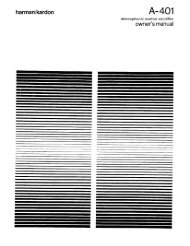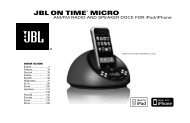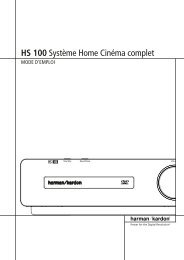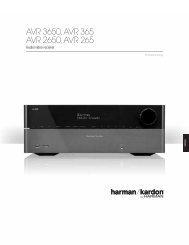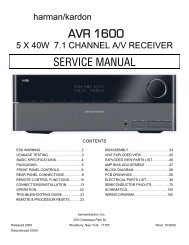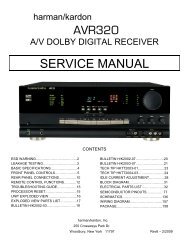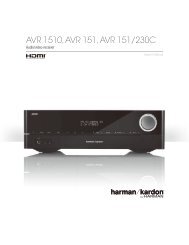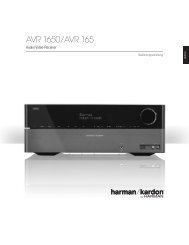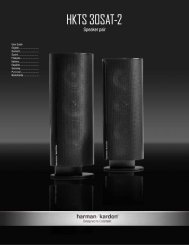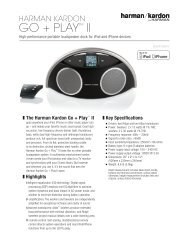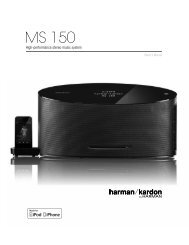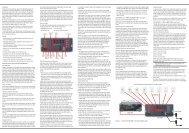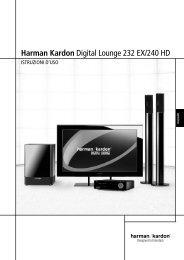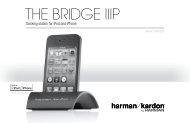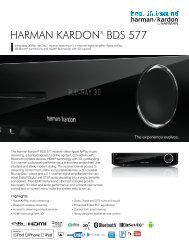Power for the Digital Revolution - Harman Kardon
Power for the Digital Revolution - Harman Kardon
Power for the Digital Revolution - Harman Kardon
Create successful ePaper yourself
Turn your PDF publications into a flip-book with our unique Google optimized e-Paper software.
Since <strong>the</strong> introduction of <strong>the</strong> Compact Disc in 1982, digital technology<br />
has gradually taken over <strong>the</strong> home entertainment world.<br />
Initially used only <strong>for</strong> playback sources such as CDs, <strong>the</strong> use of<br />
digital technology has expanded to include <strong>the</strong> recording and<br />
distribution of virtually all <strong>for</strong>ms of programming. It’s also used to<br />
compress and process audio signals so that up to eight channels<br />
of discrete in<strong>for</strong>mation may be stored in <strong>the</strong> space of two. Dolby ®<br />
<strong>Digital</strong>, DTS ® and MP3 are, each in its own way, examples of<br />
how digital technology is used to extend <strong>the</strong> playback options <strong>for</strong><br />
audio.<br />
Indeed, <strong>the</strong> digital soundtracks played back on a DVD or through<br />
a digital cable box, satellite receiver or HDTV set-top increasingly<br />
start with digital recording, and digital technology keeps <strong>the</strong>m<br />
pristine along <strong>the</strong>ir travels from soundstage to movie <strong>the</strong>aters to<br />
Un<strong>for</strong>tunately, when digital circuits exist as individual blocks,<br />
<strong>the</strong> potential <strong>for</strong> trouble has been unavoidable. Until now.<br />
With <strong>the</strong> introduction of <strong>the</strong> DPR 1001 <strong>Digital</strong> Path Receiver,<br />
<strong>Harman</strong> <strong>Kardon</strong> eliminates <strong>the</strong> need to convert digital signals<br />
back to analog between <strong>the</strong> output of <strong>the</strong> DSP and <strong>the</strong> input to<br />
<strong>the</strong> amplifier. How is this done? The simplest way to describe <strong>the</strong><br />
process is to say that <strong>the</strong> inefficient power supply, oversized<br />
trans<strong>for</strong>mers, heat-producing power transistors and large, heavy<br />
heat sinks of traditional analog amplifiers are eliminated and<br />
replaced with totally digital circuitry.<br />
The incredible system efficiency of <strong>the</strong> digital design – over 80%<br />
as compared to slightly more than 55% in a conventional design –<br />
means you have seven full channels of high-quality amplification<br />
without <strong>the</strong> need to remove heat. As important, removing <strong>the</strong><br />
entertainment system thanks to <strong>the</strong> ability to fit a DPR-based<br />
receiver in places where you never thought a high-quality<br />
audio system could fit.<br />
Because it’s <strong>Harman</strong> <strong>Kardon</strong>, <strong>the</strong> DPR’s all-digital design does<br />
not scrimp on features and flexibility. O<strong>the</strong>r products may use<br />
digital amplifiers to save space, but <strong>the</strong>y do not have <strong>the</strong> power<br />
and refinement of a DPR. Logic 7 ® and VMAx ® processing,<br />
in addition to Dolby <strong>Digital</strong>, Dolby <strong>Digital</strong> EX, Dolby Pro Logic ® II,<br />
DTS 5.1, DTS-ES ® and DTS Neo:6 ® ? Of course <strong>the</strong> DPR has<br />
<strong>the</strong>m! Seven audio channels with onboard amplifiers? We<br />
wouldn’t have it any o<strong>the</strong>r way! A full multizone system, complete<br />
with assignable amplifier channels to power it right out of <strong>the</strong><br />
DPR and a standard Zone II remote? Standard on <strong>the</strong> DPR.<br />
An easy-to-use, yet powerful remote control, complete with an<br />
digital path receiver technology<br />
production houses and DVD pressing plants, to <strong>the</strong> output of your<br />
DVD player.<br />
However, once <strong>the</strong>se digital signals reach your home <strong>the</strong>y are<br />
processed in various ways that make <strong>the</strong>m resemble digital<br />
islands connected to <strong>the</strong> analog world by bridges. In an A/V<br />
receiver <strong>the</strong>se bridges include <strong>the</strong> analog-to-digital converters on<br />
<strong>the</strong> front end of a system and <strong>the</strong> digital-to-analog converters<br />
(DACs) at <strong>the</strong> back end which convert <strong>the</strong> digital signal back to<br />
analog after <strong>the</strong> processor, or DSP, has done its work.<br />
<strong>Digital</strong> signals are virtually free from interference, but each time<br />
<strong>the</strong>y are taken apart or put back toge<strong>the</strong>r <strong>the</strong>re is <strong>the</strong> opportunity<br />
<strong>for</strong> bits to be lost or <strong>for</strong> <strong>the</strong> signal to be degraded. No matter<br />
how good <strong>the</strong> converters are – and <strong>Harman</strong> <strong>Kardon</strong> uses some<br />
of <strong>the</strong> best available – some change to <strong>the</strong> signal is inevitable.<br />
EFFICIENCY in %<br />
100<br />
80<br />
60<br />
40<br />
20<br />
DPR Efficiency Advantage<br />
Conventional<br />
0<br />
0 1 2 3 4 5 6 7 8 9 10 11 12<br />
OUTPUT POWER in Watts<br />
heat sinks, large trans<strong>for</strong>mer and cooling fan means not only<br />
that <strong>the</strong> system is totally silent; it is considerably smaller.<br />
This gives you more freedom <strong>for</strong> <strong>the</strong> placement of a home<br />
DPR<br />
LCD display and both learning and programmable functions?<br />
Certainly! The list goes on and on. After all, <strong>the</strong> DPR is a<br />
<strong>Harman</strong> <strong>Kardon</strong> receiver at heart, and no one knows how to<br />
build a receiver better than <strong>the</strong> company that invented <strong>the</strong><br />
receiver almost 50 years ago.<br />
Then <strong>the</strong>re’s <strong>the</strong> sound. It’s everything you would expect from<br />
<strong>Harman</strong> <strong>Kardon</strong> and more.<br />
Advanced technology is a bonus, but it’s <strong>the</strong> music and movies<br />
that count. The DPR 1001 <strong>Digital</strong> Path Receiver takes <strong>the</strong><br />
shortest course, direct from <strong>the</strong> original source to your speakers,<br />
preserving <strong>the</strong> quality of <strong>the</strong> per<strong>for</strong>mance. That was <strong>the</strong> reason<br />
digital technology was originally applied to home entertainment.<br />
With <strong>Harman</strong> <strong>Kardon</strong>’s new digital path receiver, <strong>the</strong> promise of<br />
<strong>Power</strong> <strong>for</strong> <strong>the</strong> <strong>Digital</strong> <strong>Revolution</strong> ® is finally realized.



